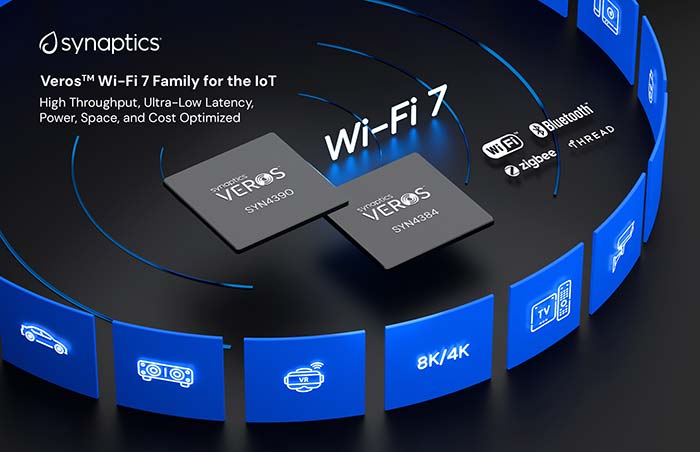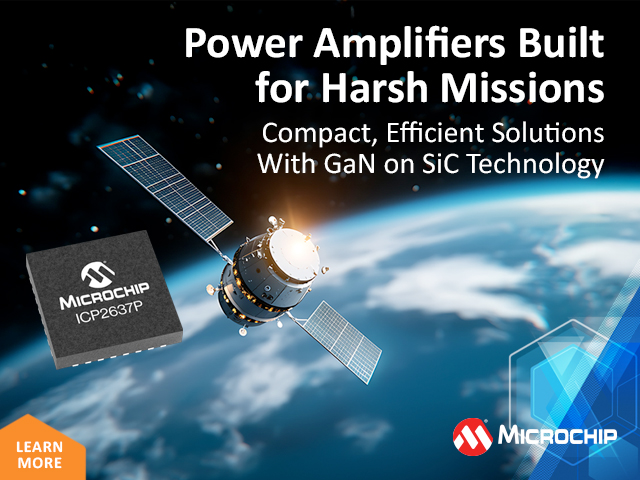Synaptics® Incorporated announced it has extended its Veros wireless portfolio with its first family of Wi-Fi® 7 systems-on-chips (SoCs) tailored for the Internet of Things (IoT). Comprising the SYN4390 and SYN4384, the scalable offering supports bandwidths up to 320 MHz to deliver 5.8 Gbps peak speed and low latency. The triple-combo SoCs integrate Wi-Fi 7 with Bluetooth® 6.0 and Zigbee/Thread, support Matter, and are designed to minimize system cost and power consumption. They target IoT applications requiring reliable performance-over-range for enhanced user experiences across use cases that include 8K video streaming, interactive gaming, security monitoring, immersive AR/VR, and home and automotive entertainment.
Wi-Fi 7’s multi-link operation (MLO) allows the devices to send and receive a data stream using multiple frequency bands (2.4 GHz, 5 GHz, 6 GHz) simultaneously in support of low latency, reliable connections, and high throughput for real-time applications like video calls and gaming. Synaptics’ architecture provides a power-efficient, cost-effective way to deliver the benefits of MLO.
Comments
“Growing adoption of Wi-Fi 7 in wireless networking infrastructure has created an opportunity to address a massive and diverse array of Wi-Fi 7-enabled IoT end-user devices by extending our Veros portfolio,” said Venkat Kodavati, SVP and GM of Wireless Products at Synaptics. “We are bringing the benefits of Wi-Fi 7 in a versatile solution for high-performance, low-power IoT devices. Combined with the ease of integration with our Astra AI-Native compute platform, we expect that developers will have an efficient solution for implementing next-generation connected and AI-enriched IoT products with features such as Wi-Fi Sensing.”
ABI Research forecasts annual shipments of Wi-Fi 7 chipsets to reach more than 2 billion by 2029, achieving a CAGR of 56% between 2024 and 2029.[1]
“Wi-Fi 7 is ushering in a new era of more enriching and sophisticated use cases for connected devices thanks to its channel bandwidth, throughput, and latency improvements,” said Andrew Zignani, Senior Research Director, ABI Research. “However, the requirements for implementation vary by product type, and edge IoT introduces challenges that differ from PCs or infrastructure applications. Synaptics’ diverse Wi-Fi 7 solutions are tailored to address these unique needs, including low power, support for multiple connectivity protocols, and AI. These will be critical in enabling Wi-Fi 7’s expansion across multiple IoT segments, reaching billions of annual device shipments over the next few years.”
Veros Wi-Fi 7 family highlights
The Veros Wi-Fi 7 IoT family’s support of Matter and its triple combo design provides the interoperability required to allow the devices to serve as versatile home hubs that can operate across Wi-Fi, Bluetooth, and Zigbee/Thread networks in heterogeneous wireless environments. Features support[2]:
- Peak speed of up to 5.8 Gbps, using 2×2 + 2×2 MLO, 320 MHz channel bandwidth, and 4K QAM
- Integrated RF front-end and power management IC (PMIC) that contribute to reduced system cost and power consumption
- Dual-core Bluetooth 6.0 for LE Audio, Channel Sounding, and LE Long Range
- Matter and an integrated 802.15.4 radio capable of enabling Zigbee and Thread networking[3]
- Integrated Arm cores and memory to enable offloading of networking functions from the host processor to help reduce system power consumption[4]
Availability
The SYN4390 is available now for sale, and the SYN4384 is available now in limited quantities for evaluation.
[1] Source: ABI Research Article: Wireless Connectivity Technology Segmentation and Addressable Markets by Andrew Zignani (published January 27, 2025) ©2025 Allied Business Intelligence, Inc.
[2] Actual performance may vary based on deployment environment and device configuration
[3] Certification status may vary by implementation
[4] Power savings may vary based on system design and workload




